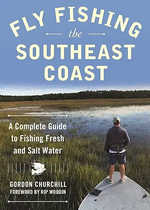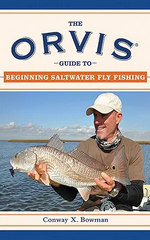Fly fishing is fly fishing is fly fishing. Pretty simple. In our dreams. There are several distinctions between fly fishing in freshwater and fly fishing in saltwater aside from the general observation that fly rods, lines, and reels for saltwater are heavier and reels need to have both a good drag and far more line capacity since the line is thicker and takes up more room on reel. Also, a larger reel is needed to hold the line and sufficient backing for the size fish you want to catch. My saltwater reels tend to have at least 200 yards of backing- usually 20 lb. test Dacron (30 lb. test on 10-wt. reels on up).
1. Different casting strokes
Fresh water
Since most casts in fresh water are short (40’ or less), the rod does not need to be moved over a great distance to build up line speed for a long-distance cast. Often, the angler can face the target, point the rod tip toward the water, work out the slack and make a modest back cast by bringing the rod back to a 1:00 position, bending the wrist as necessary. After the back cast has almost finished straightening out, start bringing the rod tip forward with a gentle hurry up and stop at about the 10:00 position, lowering the rod tip toward the water slowly toward the water’s surface as the fly is close to landing on the water.
Since many streams have trees and bushes along the banks, particular casts need to be made with the roll cast (see paper # 10).
When trying to cast under overhanging limbs, it may require the angler to cast side- arm to keep the fly and line coming in low over the water so it can go underneath the obstruction.
Another approach to overhanging limbs or docks & piers, especially if there is no room for a back cast, is to use the rod and fly in a bow & arrow-like way. Hold the fly with the line hand and pull a short amount of line back like an arrow. Clamp the fly line coming off the reel with a finger of the rod hand to keep it from pulling through the guides. You want to bend the rod as you would bend a bow when preparing to shoot an arrow. With sufficient bend in the rod, let go of the fly and release the line clamped by the rod hand against the rod handle. Watch the line and the fly shoot underneath the limbs or between the pilings. Obviously, this cast should be practiced prior to employing it while fishing.
Avoid unnecessary back casts. Many freshwater fish look up and usually feed on items that are above them. Seeing the line (or even just the shadow of the line) going back and forth above them can alert the fish to your presence.
The same is true if you are using false casts to determine the amount of line you need to cast. Never cast toward the fish to measure the distance. Cast off to the side at right angles to the fish,
Saltwater
In saltwater, you may be making longer casts which require you to increase your line speed a bit more than in fresh water. To build up more line speed, you need to made a longer back cast to provide sufficient bend in the fly rod to make a longer forward cast. This can be done using a side-arm casting style if there is much wind where you are fishing or you are trying to get under a dock or pier.
But fish aren’t always a million miles away. Sometimes you will see a fish less than 10’ from you. With a 9’ rod and a 9’ leader, trying to make much of a cast is out of the question. This is where your familiarity with your fly rod and your comfort level with it become important. When you are preparing to fish or practice, mess around with the rod some, trying to figure what it will do with only a foot or so of fly line out the tip. This practice could wind up getting a nice fish in the boat some day as you use your fly rod as a cane pole and flip a fly at a fish very close to the boat. Be adaptable and creative.
2. Different ways to set the hook
Freshwater
Many fresh water fish eat by coming from underneath the food item, grabbing it and then returning to their hiding place, often near the bottom of the stream. By lifting the tip (tip set) of the rod when you have a strike, you are lifting the fly into the roof the fish’s mouth, which is where you would like the hook to stick. Since a lot of fresh water fishing takes place on small streams that are not too deep, lifting the rod tip to set the hook many very well pull the fly off of the water surface or out of the water if submerged. In some situations, a quick cast back to where the strike occurred may yield another strike. So be prepared to cast quickly in such circumstances.
Also note that many times a fish will follow a fly before striking it. Then they will return to their original location which may be several feet or more from where the strike occurred. Take this into consideration and cast back to an area 10’-15’ upstream from where the strike occurred since the fish may have been floating downstream for 5’-6’ checking out the fly before striking it. You want to cast to where the fish will return to set up instead of where it finally decided to strike. If you cast back to where the strike happened, it could well be 6’-10’ downstream from the fish and the fish is looking upstream to see what’s coming next. In other words, you will miss casting to that fish. Add on another 5’ or more to give the fly time to get to the level in the water where the trout will notice it. Hence the 10’-15’ cast upstream of the strike.
Saltwater
Saltwater fish can approach their prey from any angle (below, above, from the sides) and sometimes they bump or even maim their prey before coming back and eating it. Some, like a flounder, will grab the bait, scale it and turn it around so they can swallow it head first. Raising the rod tip on a strike can pull the bait up off the water, meaning it is not there when the fish turns around to finish the job of eating his prey.
Also, saltwater fish can have tougher mouths since so many of their prey have sharp fins, razor sharp gill plate edges, and some fairly fierce teeth. Setting a hook requires a fair degree of strength to drive the hook into the hard bones.
For these reasons, we employ a strip set in which we keep the rod tip pointed to the fish in the water and use the line hand to give several hard jerks of the line. This way we can put far more force behind the hook set than if we just pulled up the rod tip. The rod tip bends readily in part because it limits the force placed on a light tippet. Secondly, we will not move the fly more than a foot or so. In other words, it is still in the water near where a fish grabbed it so it is still there when the fish turns around to finish the job.
3. Different needs in caring for our equipment
Freshwater
For the most part, despite pollution, freshwater is not overly caustic. It may be muddy with lots of weeds and strange stuff growing in it but these gunk up you outfit instead of eating up the metals.
With the accumulation of too much dirt, grime and gunk you can hear the line going through the line guides with a distinctive sound. It is time to clean your line. You need not wait until you get home that night if you find your casts winding up short or it seems you have to haul a little faster to get the rod to cast properly.
Get out a clean rag (or at least moderately clean), make a long cast to get a lot of line on the water (meaning the line is wet) and then strip it or reel it in, letting it come through a rag or towel you are using to pinch the line so pulling the line through the rag or towel provides some pressure on the line, wiping off (cleansing guidelines).
Depending upon use, clean your fly line thoroughly every few months.
Saltwater
Saltwater can eat up cheaply made equipment in a heart-beat. If you can get a week of use out of some cheap tackle you bought for your kids or grandkids to use on a beach vacation, those items don’t owe you a thing.
With more expensive tackle you want to fight the salt by rinsing the line, reel and fly rod every day, if possible.
Line-
Pull the fly fishing line off the reel and into a sink while running water to soak the line (and make it easier to get the line off the reel). Don’t worry too much about the backing.
Rod-
Take the rod down and rinse each portion well, paying special attention to the reel seat, lock-up nobs and line guides. Make sure you wash the inside of the line guide feet- the part where the feet are no longer in contact with the rod blank. Some people usually coat these areas with clear fingernail polish of rod cement to seal them against water intrusion and rust. Dry the rods with a cloth and store them- but not in their rod tubes. Again, see paper the guidelines.
Rinse off the cork handles but don’t try to clean them and be sure to remove the plastic sleeve when you buy the rod.
Reel-
Rinse off you reel thoroughly after each outing in saltwater. Let it air dry and then store it in a place out of direct sunlight (which hurts the line). Do not store it in its case or any sort of plastic or cloth bag. Make sure the drag is set at its lightest setting- a rule that began with but is not limited to cork drags.
Use oil sparingly. You don’t want a drag that doesn’t provide the drag you want but you don’t want rust and corrosion to render them ineffective, either.
Don’t forget to check out the resources of Fly Fishers International at www.flyfishersinternational.org.
Also, Google this and other topics of interest and go to YouTube for seemingly endless videos.



